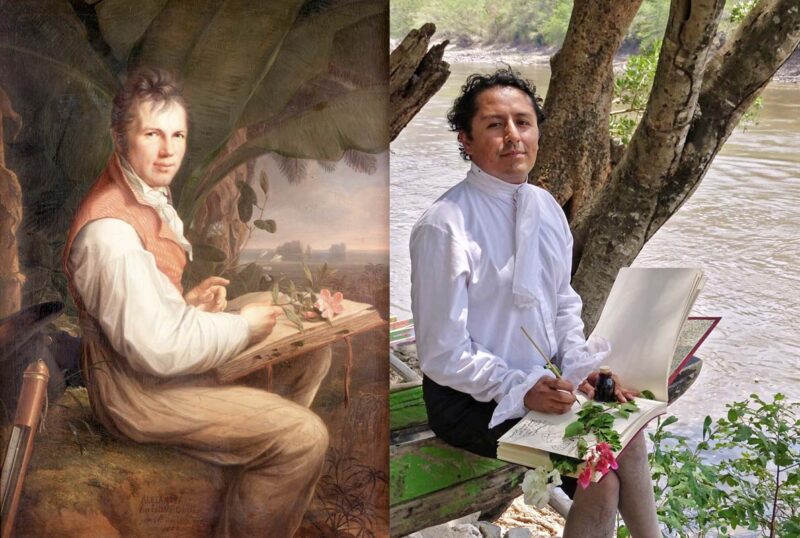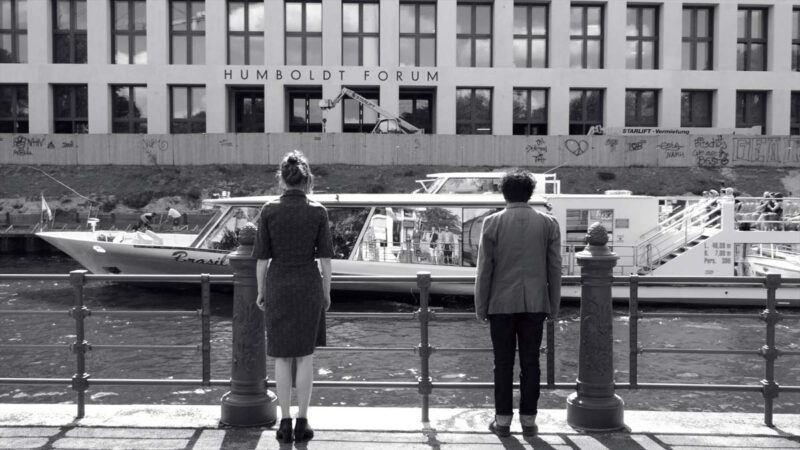[Summer 2024]
by Gabrielle Sarthou
[EXCERPT]
The exhibition Archive Alexandre de Humboldt Montréal, organized in collaboration with the independent curator Emmanuelle Choquette, is part of a project built over more than ten years by the Ecuadorian artist, curator, and director Fabiano Kueva, whose works combine sound art, installation, and experimental video. It was presented as an extrapolation of – or a historical, geographic,
and social reflection and performance around – the voyages to the Americas of Alexander von Humboldt, a German explorer and naturalist, from the late eighteenth to the early nineteenth century. Far from being an homage to Humboldt, the project is an invitation to undertake a critical reconsideration of the narratives upon which Western scientific and cultural heritage is based.
The exhibition visit at Oboro began with a small screen on a green wall, showing a short video with black-and-white images of the Humboldt Forum, which bills itself as the first “international post-museum” and is housed in a recent reconstruction of a building erected between the sixteenth and the nineteenth century (the Berliner Schloss). As viewers watched stop-motion animations and views of the building taken with a drone, subtitles informed them that the museum will display archaeological and ethnographic collections from Africa, the Americas, Asia, and Oceania in the possession of the German government, many objects in which come from Humboldt’s voyages. The video starts with a question: What will be the fate of these European collections and cultural assets of colonial origins?
In the small gallery, two jute bags were attached to the wall on the left, one from the Berliner Schloss and the other from the Humboldt Forum, coexisting
anachronistically. Beneath them, various objects related to the newer building were arranged: documentation of symposia; books in German, English, and Spanish; a construction helmet; books celebrating the 250th anniversary of Humboldt’s discoveries; articles that, one imagines, were unearthed and gathered by Kueva. Nearby sat a well-worn notebook that could be perused: Kueva’s Journal de Berlin. Slowly, viewers assembled the different pieces of the puzzle formed by archives with scattered temporalities.
At the back of the gallery was the video work Self portrait on strike background (2020). It shows the image of an empty bed accompanied by a man’s voice saying that the practice of writing may
be a threat to the symbolic security of others, even though it is an apparently banal act. In the catalogue published
for the exhibition, Kueva explains that expeditions narrated, edited, and published by explorers form a biased means of production and dissemination of knowledge, and he makes a play on words, “Autor/idad,” connecting the words “author”
and “authority.” Writing, he proposes, can have major repercussions over time, and he invites viewers to reflect on the explorers’ legitimacy and their scientific and intellectual authority. Finally, at
the centre of the large gallery, was an Aztec calendar. To its left were shelves containing wicker baskets and small South American stone sculptures. To its right, colourful embroideries illustrated specific events, including the eruption of Cotopaxi, a fire in the Humboldt Forum, and forest fires in Quebec. Emulating Humboldt’s collecting, annotation, and classification methods, Kueva has built archives with contemporary natural and cultural specimens. Juxtaposed against the specimens were images in frames of
different sizes and shapes attached to the wall. The images, which come from
a variety of sources, included popular etchings portraying indigenous people,
in the style of portraits imagined and idealized by colonizers; an old world map; and a photograph of a drawing of a nineteenthcentury exhibition, containing an Aztec calendar similar to the one displayed at Oboro. Everything in this exhibition was a play on tensions between
archives and reality.
The exhibition concluded with another video work, Todas las plantas del mundo,
a chapter from the film Ensayo Geopoético, featuring the anachronistic character
of Kueva, positioned in a contemporary temporal context but dressed in seventeenth-century attire. Sometimes he
is simply observing his surroundings, sometimes drawing. The character walks through two botanical gardens, one in France and the other in Peru, highlighting the contrasts between the institutions.
Archive Alexandre de Humboldt Montréal was a dense exhibition, inviting viewers to think differently about histories often taken for granted. Humboldt’s travel
accounts provided information essential
to feeding the imperialist machine that considered nature a planetary reserve
for capital. The aestheticized objects and natural specimens amplified a vision that bisects the world, with the Global South representing a natural paradise to be conquered and its fruits to be collected. The exhibition also encouraged viewers to think about the indirect influence exerted by the museum and how this occurs. With his performative collecting methods, Kueva urges us to reconsider the legacy of celebrated European explorers.
Translated by Käthe Roth
–
Gabrielle Sarthou is studying for a master’s degree in art history at UQAM and teaching at a CEGEP. Sarthou’s research, focused on gender studies, involves historiography and colour theory. As a curator and art critic, Sarthou likes to connect art and words by contributing to a number of cultural magazines, including Ciel variable, ESPACE art actuel, and Vie des arts.
–
1 I was able to trace the origin of this exhibition, which was called Ancient Mexico and in which William Bullock presented Aztec objects (originals and castings). The exhibition took place in 1824 in the Egyptian Hall in Piccadilly, London.
[ Complete issue, in print and digital version, available here: Ciel variable 126 – TRAJECTORIES ]
[ Complete article, in digital version, available here: Fabiano Kueva, Archive Alexandre de Humboldt Montréal – Gabrielle Sarthou
]




